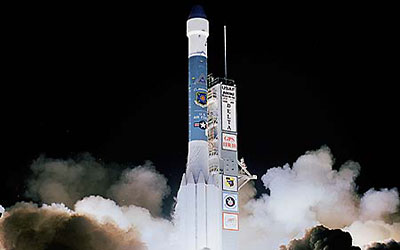A year-end reality checkby Jeff Foust
|
| The bigger problem with Pulham’s statement is the belief that 51, let alone 59, launches in a year represents a “hectic” level of activity. Actually, nothing could be farther from the truth. |
However, the commercial launch industry has gone bust in the last few years, thanks to a weakened global economy and the notorious collapse of Iridium and Globalstar, among other satellite ventures. In 2001 there were only 59 orbital launches worldwide—the smallest annual tally since the early 1960s—and just 65 in 2002. This year’s final number will fall between those two data points, making it clear that this is no aberration but instead a new steady state for the global launch industry.
There is also evidence that this low level of activity represents a long-term trend. The Analysis of Space Concepts Enabled by New Transportation (ASCENT) market study performed by the Futron Corporation for NASA shows a baseline global launch demand (assuming no significant changes in launch prices) that remains relatively steady at between 70-80 launches a year through the end of the forecast in 2021. (It should be noted that the report forecast a demand for nearly 80 launches a year in both 2002 and 2003, overestimating the actual number of launches.) The ASCENT forecast assumes growing launch demand from emerging markets, notably space tourism; without it, the report’s executive summary notes, “there would be a rather rapid decline of the launch industry during the second decade of the forecast period.”
So, why should we care about the number of launches, and whether 2003 represented a “blistering pace” or a tepid one? The number of launches is a key metric of the overall health of the launch industry. In the 1990s the industry responded to what appeared to be a permanent increase in demand for commercial launches by developing new vehicles that were larger and could launch at a higher frequency than their predecessors. With launch demand now lower than in the 1990s, let alone what was then forecast for the 2000s, there is tremendous overcapacity in the launch market. At a Society of Satellite Professionals International (SSPI) event in Washington DC in November, Robert Bocek, Director of Space and Technology for Boeing, noted that six major large boosters available today—Ariane 5, Atlas 5, Delta 4, H-2A, Proton, and Zenit 3SL—have a combined capacity of 78 launches a year. However, these vehicles combined account for just 15-20 launches a year, 16 so far in 2003. “It is an understatement to say there is a glut,” Bocek said.
If these vehicles served solely commercial customers, this overcapacity would be less of a concern: market forces would take care of the problem, most likely by driving some of the competitors from the field. This has already happened to a minor degree, when Boeing announced this summer that it would no longer offer the Delta 4 to commercial customers (never mind the fact that the booster had attracted little commercial interest in recent years.) However, launch is far from a strictly commercial industry, and is heavily influenced by issues of national security and national prestige. As a result, we see today efforts like “assured access to space” in the US, a bid to ensure that there are at least two major domestic launch vehicle providers; and “guaranteed access to space” in Europe, where ESA will help to underwrite costs associated with the Ariane 5 to make sure it remains competitive in the global marketplace. These and other efforts will potentially cost taxpayers billions of dollars, euros, rubles, and yen in the next decade. A launch industry that was truly “hectic” would have little need for such subsidies.
| “It is an understatement to say there is a glut” of launch vehicles, Boeing’s Bocek said. |
This is not to say there is no hope for the launch industry. The last year has seen growing interest in new markets, such as space tourism and “responsive” space access—the rapid launch of small payloads, primarily for military purposes. However, it seems unlikely that the current slate of large launch vehicles can serve these new markets: space tourism is limited to the existing Soyuz vehicle as well as the crop of suborbital vehicles under development competing for the X Prize. The responsive space access community is looking for relatively small launch vehicles that can launch on no more than a few days’ notice: not only would launching a microsat on a Delta 4 be overkill, it’s unlikely the vehicle could be launched in the narrow timeframe currently envisioned for responsive launch vehicles. These new markets will likely require new vehicles.
In short, to call the level of launch activity in 2003 “hectic” or a “blistering pace” is nothing short of ludicrous. The numerous problems the launch industry faces today stem in large part from the lack of launch activity compared to just the recent past, let alone historic peaks. Moreover, there is little to suggest an easy solution to these problems any time in the foreseeable future.
Pulham is on the right track in his editorial in some respects by pointing out the highlights of the year that are often lost in the glare created by the Columbia accident and its aftermath. 2003 wasn’t quite the annus horribilis some make it out to be, but at the same time any congratulations should be muted. Rather than patting ourselves on the back for the level of launch activity that took place, we should be putting our thinking caps on to try to find ways out of our current quandary. If we can do that, we can one day have a level of activity in the industry that can truly be called hectic.
